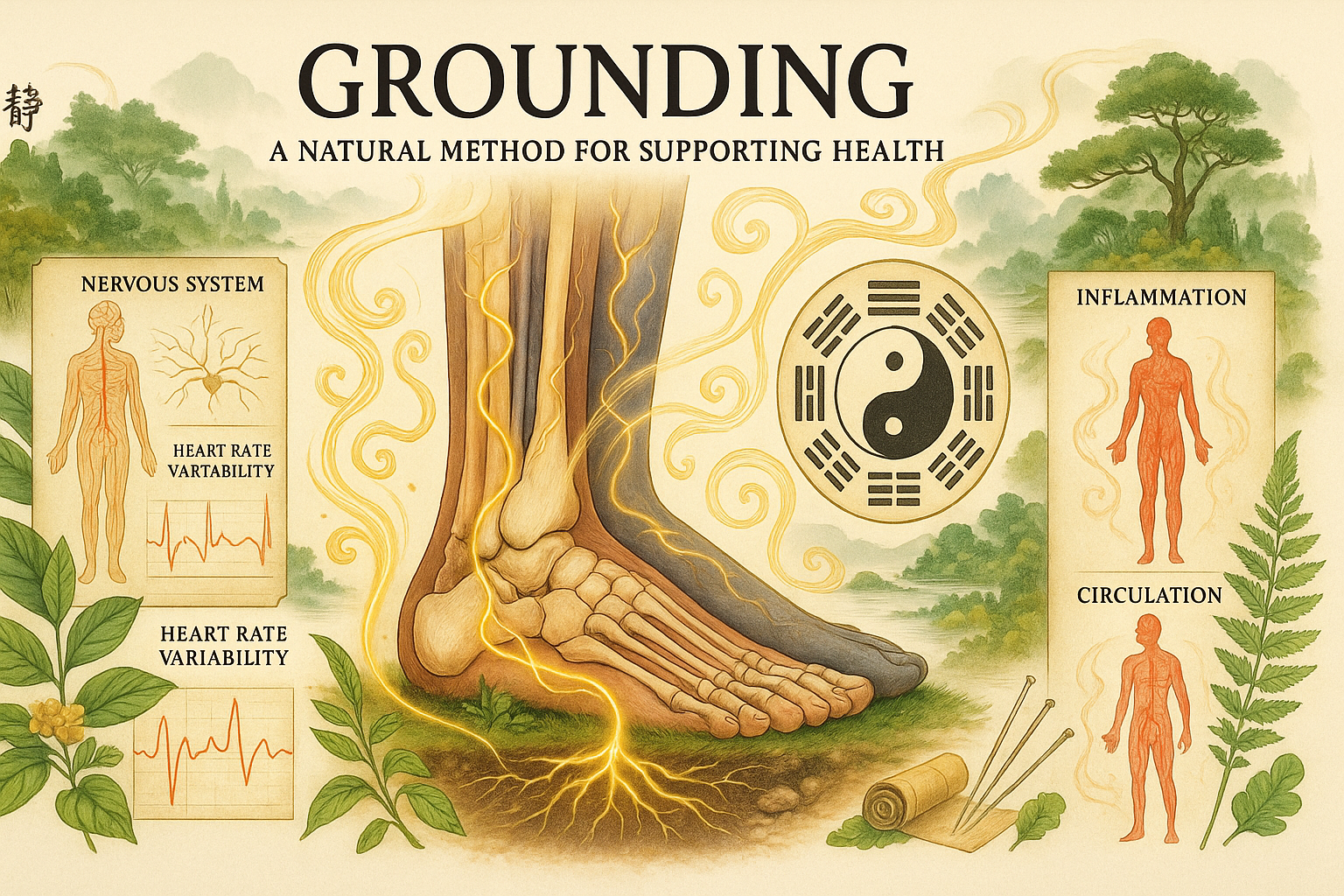🔍 Introduction
Have you ever wondered why walking barefoot on the beach or grass gives you a feeling of relaxation and inner peace? What we intuitively experience as pleasant may have a deeper physiological basis. Contact with the Earth’s surface, called grounding or “earthing,” is becoming the subject of increasing interest among researchers.
Grounding is simply direct contact between the body and the natural surface of the Earth – it can be grass, sand, soil, or even water in a natural reservoir. The Earth is a rich source of electrons with antioxidant properties that can help the body maintain balance and health. When we connect with the Earth, our body can absorb these electrons, leading to a range of potential physiological benefits.
🔋 Understanding Grounding from a Chinese Medicine Perspective
In Traditional Chinese Medicine (TCM), the concept of Qi (pronounced “chee”) represents the vital energy that flows through all living things. This energy circulation is fundamental to health and vitality in the TCM paradigm. Interestingly, modern science allows us to draw parallels between this ancient concept and electrical energy in the body.
The electrical nature of Qi can now be measured with modern instruments. Using simple electrical meters, researchers have documented changes in the body’s electrical conductivity when a person makes direct contact with the Earth. These measurements show an equalization of the body’s electrical potential with the Earth’s potential during grounding (a decrease in voltage relative to Earth), which corresponds to what TCM would describe as balanced Qi flow.
From a TCM perspective, grounding helps balance and harmonize the body’s energy systems. It supports the smooth flow of Qi, helping to remove blockages and stagnation that could lead to discomfort or illness. This electrical connection with the Earth serves to “recharge” our bodies’ energy systems, similar to how TCM practices like acupuncture aim to balance the flow of Qi through meridians.
Scientific instruments can now measure this energy exchange – when we make direct contact with the Earth, there is a measurable change in our body’s electrical potential. This provides a fascinating bridge between ancient wisdom and modern scientific understanding, showing how grounding practices can influence our body’s energetic and electrical systems in measurable ways.
✨ Potential Health Benefits of Grounding
🔥 Reduction of inflammation and oxidative stress
Research suggests that grounding may alleviate inflammatory reactions in the body. In a model of muscle damage (DOMS), it was observed that grounded individuals had less inflammatory response after physical exertion. The number of circulating neutrophils and lymphocytes was lower than in non-grounded people, which may indicate faster resolution of inflammation and less tissue damage.
https://www.ncbi.nlm.nih.gov/pmc/articles/PMC3116537
The mechanism behind this phenomenon may be the antioxidant effect of electrons taken from the Earth – hypothetically, they neutralize reactive oxygen species (ROS) in inflammation sites. As researchers state: “direct contact with the planet’s surface generates a kind of electrical nourishment with surprisingly strong and rapid anti-inflammatory and antioxidant effects.”
https://www.ncbi.nlm.nih.gov/pmc/articles/PMC4378297
In practice, grounding was associated with less tissue damage from free radicals and faster regeneration. Grounded patients were observed to have fewer leukocytes in inflammation, which may indicate more efficient resolution of the inflammatory process.
https://www.ncbi.nlm.nih.gov/pmc/articles/PMC3265077
🧠 Improved nervous system function
Grounding may beneficially influence the regulation of the nervous system, especially the autonomic system. A rapid shift in dominance from the sympathetic system (“fight or flight”) to parasympathetic (“rest and digest”) was observed in grounded individuals, indicating calming of the body and reduction of stress.
https://www.ncbi.nlm.nih.gov/pmc/articles/PMC3154031
Studies have noted improvements in heart rate variability (HRV) and normalization of muscle tension, among other effects. After just a few dozen minutes of grounding, there was an increase in vagus nerve (parasympathetic) activity and a decrease in sympathetic activity.
https://pubmed.ncbi.nlm.nih.gov/20192911
Interestingly, the effect of grounding on the nervous system has also been confirmed in clinical settings. In premature infants in incubators, one-hour grounding sessions significantly raised vagal tone (increased high-frequency component of HRV by about 67%), which may improve their response to stress.
https://pubmed.ncbi.nlm.nih.gov/28601861
😴 Regulation of circadian rhythm and sleep
There are reports that grounding may normalize the circadian rhythm of hormones and improve sleep quality. In a pilot study involving 12 people with chronic sleep disorders and pain, sleeping on a conductive grounding mat for 8 weeks led to a significant improvement in subjective sleep quality and changes in the diurnal cortisol profile.
https://pubmed.ncbi.nlm.nih.gov/15650465
The subjects showed a reduction in elevated nighttime cortisol levels and general equalization of the rhythm of secretion of this stress hormone throughout the day – the diurnal curve approached the normal physiological shape. At the same time, almost all participants reported a reduction in perceived stress, tension, and pain, as well as easier falling asleep.
https://pubmed.ncbi.nlm.nih.gov/16596749
Normalization of the cortisol profile through grounding may explain the improvement in sleep – it is known that elevated levels of this hormone at night disturb sleep, and its reduction promotes regeneration. This relationship is confirmed by the results – where grounding corrected the cortisol rhythm, there was an improvement in the length and depth of sleep.
https://www.ncbi.nlm.nih.gov/pmc/articles/PMC3265077
❤️ Improvement of rheological properties of blood
One of the best-documented effects of grounding is its impact on blood and circulation. A study published in the Journal of Alternative and Complementary Medicine (2013) showed that 2-hour grounding of healthy individuals causes an increase in the negative charge on the surface of erythrocytes (zeta potential) by an average of 2.7 mV and a significant reduction in red blood cell aggregation.
https://www.ncbi.nlm.nih.gov/pmc/articles/PMC3576907
In other words, after grounding, the blood was thinner – red blood cells were less likely to clump together in rouleaux, and blood viscosity decreased. Microscopic dark-field images of blood show a clear difference: after a few dozen minutes of grounding, erythrocytes separate instead of forming dense clusters.
https://www.ncbi.nlm.nih.gov/pmc/articles/PMC4378297
Improvement in these rheological parameters has significant health implications – high blood viscosity contributes to hypertension and heart disease. Grounding, by increasing the charge on blood cells, lowers viscosity and flow resistance, which may translate into a reduced risk of thrombosis and cardiovascular events.
https://www.ncbi.nlm.nih.gov/pmc/articles/PMC5654378
🌱 How to Practice Grounding?
There are several simple ways to incorporate grounding into daily life:
- Walking barefoot 👣 on grass, sand, soil, or even concrete (but not on asphalt, which is an insulator)
- Swimming 🏊♂️ in natural bodies of water such as lakes, rivers, or the ocean
- Sitting or lying 🧘♀️ directly on the ground, e.g., during a picnic or rest in the park
- Gardening 🌻 without gloves, allowing direct contact with the soil
- Using grounding products 🛌 at home, such as mats or grounding sheets (connected to the electrical ground in the home)
🔌 Copper Wire Method (Home Grounding)
Particularly noteworthy is the grounding method using copper wire, which allows for grounding even while sleeping in an apartment. It involves:
- Running a copper wire (uninsulated) through a window to the outside of the building
- Placing one end in the soil (preferably moist)
- The other end of the wire should have contact with the body, e.g., by placing it in bed under the sheet
- For better contact with the body, you can use a special wristband or ankle band connected to the wire
This method is particularly valuable for people who do not have the opportunity to be barefoot outdoors for extended periods but want to enjoy the benefits of grounding, especially during sleep. Studies show that nighttime grounding can have a particularly beneficial effect on sleep rhythm and cortisol regulation.
https://pubmed.ncbi.nlm.nih.gov/15650465
⚠️ Safety note: When using this method, make sure that the copper wire does not have contact with electrical installations and is not connected to an electrical outlet. Grounding should only take place through contact with the earth.
🌍 Summary
Scientific studies show that grounding can be an effective method of supporting health through natural electrical processes occurring between our body and the Earth. Effects observed in studies, such as reduction of inflammation, improvement of nervous system function, better sleep quality, or beneficial changes in blood parameters, indicate the potential of this simple practice.
Grounding is a valuable, cost-free complement to a healthy lifestyle. This is particularly important nowadays when most people spend a lot of time in buildings isolated from the earth, wearing shoes with non-conductive soles. Regular grounding practice can help us regain natural electrical balance and support physiological processes of the body.
The content provided is for informational purposes only and does not constitute medical advice. It is not intended to replace professional medical consultation or treatment by a licensed physician.
Disclaimer: This article is for informational purposes only and is not intended to diagnose or treat any medical condition. Always consult with a healthcare provider before starting new health practices.


